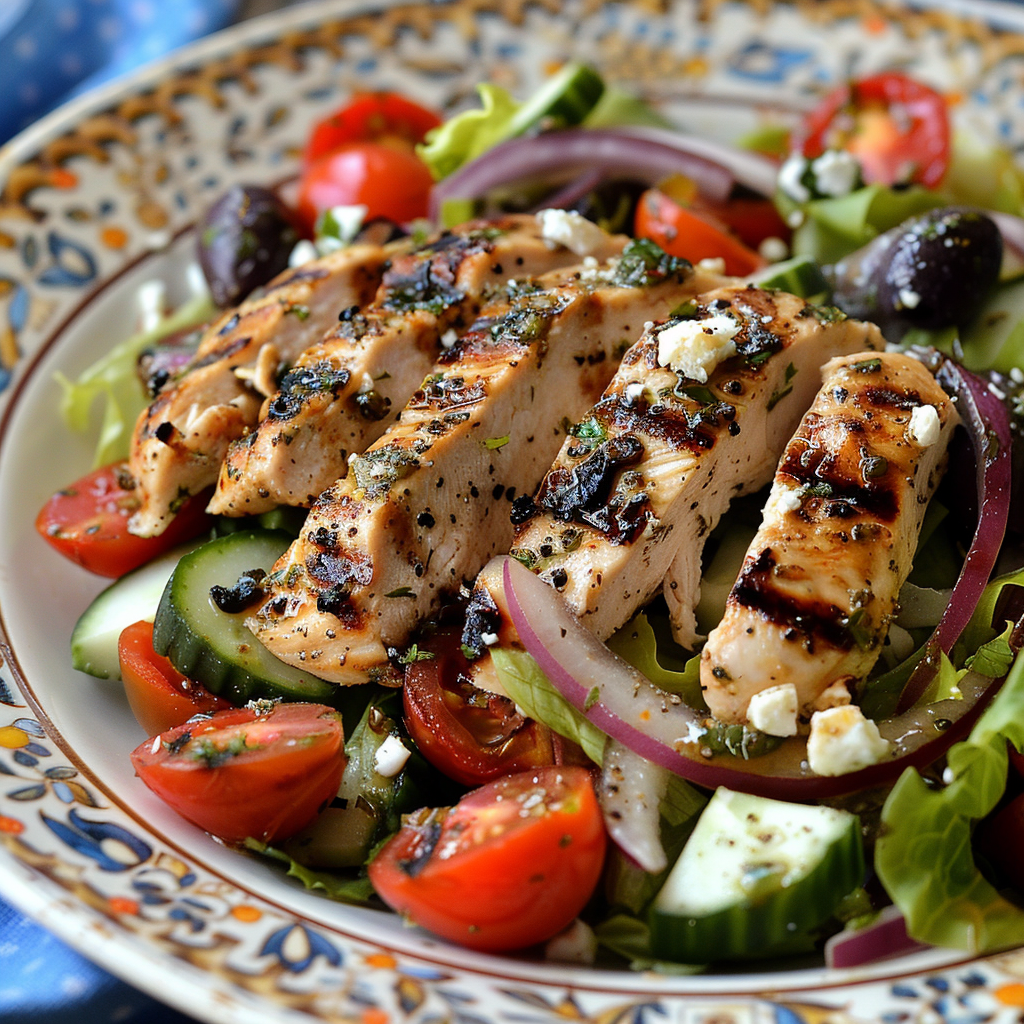Greek Salad & Grilled Chicken: A Wholesome and Vibrant Mediterranean Delight

Share
Experience Fresh Flavors of the Mediterranean In This Dish.
In my kitchen, fresh vegetables are always abundant. I love using crisp cucumbers, ripe tomatoes, and leafy greens, especially when they're harvested straight from my garden. When my garden isn’t producing, I turn to organic produce from natural food stores, ensuring I stay true to my values of health and sustainability. When I choose to include meat, I opt for organic, humanely raised chicken, knowing that quality and mindful selection play a key role in nourishment. This thoughtful approach to ingredients not only feeds my body but also brings peace of mind, knowing I’m making choices that promote both well-being and sustainability.
Did You Know?
Greek Salad, also known as "Horiatiki," originates from Greece and is celebrated for its simplicity and fresh ingredients. Traditionally, it features crisp cucumbers, juicy tomatoes, tangy red onions, briny Kalamata olives, and creamy feta cheese, all dressed with olive oil and herbs. This salad reflects the Mediterranean diet's emphasis on wholesome foods and vibrant flavors, making it a favorite worldwide for its balance of textures and tastes.
Yield: 4 servings
Ingredients:
- 1 lb chicken breast
- 4 cups mixed greens
- 1 cucumber, sliced
- 1 cup cherry tomatoes, halved
- 1/2 red onion, thinly sliced
- 1/4 cup Kalamata olives, pitted and halved
- 1/4 cup feta cheese, crumbled
- 2 tbsp olive oil
- 1 tbsp red wine vinegar
- 1 tsp dried oregano
- Salt and pepper to taste
Instructions:
Prepare Chicken:
Season the chicken breasts with salt, pepper, and dried oregano. Grill over medium heat for 6-7 minutes per side or until cooked through. Let rest, then slice.
Personal Tip: Letting the chicken rest after grilling allows the juices to redistribute, keeping the meat tender and juicy.
Make Dressing:
In a small bowl, whisk together olive oil, red wine vinegar, salt, and pepper.
Personal Tip: To enhance the flavor, add a pinch of dried oregano to the dressing for that authentic Greek touch.
Assemble Salad:
In a large bowl, combine mixed greens, cucumber, cherry tomatoes, red onion, Kalamata olives, and feta cheese.
Personal Tip: Toss the salad gently to keep the delicate greens intact and evenly coated with the dressing.
Dress and Toss:
Drizzle the dressing over the salad and toss gently to combine. Portion out to 4 servings.
Personal Tip: Dress the salad just before serving to prevent the greens from wilting and to maintain the salad's crispness.
Add Chicken:
Top each of the salads with sliced grilled chicken.
Personal Tip: For added flavor, squeeze a bit of fresh lemon juice over the chicken slices before adding them to the salad.
Serve:
Serve immediately.
Personal Tip: For a complete Mediterranean meal, serve the salad with a side of warm pita bread.
Nutritional Information (Per Serving):
Calories: 320 | Total Fat: 16g | Saturated Fat: 5g | Cholesterol: 90mg | Sodium: 420mg | Total Carbohydrates: 10g | Dietary Fiber: 3g | Sugars: 4g | Protein: 34g
Kitchen Tips, Great Ideas, How to Save Money
-
Affordable Protein: Opt for chicken breast when it's on sale or in bulk to save money. Grilling the chicken adds flavor without excess fat, making it a healthy and cost-effective choice.
-
Bulk Buying Greens: Purchase mixed greens in larger quantities or grow them in a garden if possible. This reduces per-serving costs and ensures fresh, nutrient-rich greens for salads.
-
Preserve Freshness Naturally: Store cherry tomatoes at room temperature away from direct sunlight to maintain their natural flavors and textures. Cucumbers can be stored in the refrigerator to prolong their freshness and crispness. Proper storage helps preserve ingredients for Greek Salad & Grilled Chicken without compromising on taste or wasting energy.
-
Versatile Ingredients: Use leftover feta cheese in other recipes like pasta dishes or omelets. It adds a creamy texture and tangy flavor, enhancing various meals without additional cost.
-
DIY Dressing: Make your own dressing with olive oil, red wine vinegar, and dried oregano. It's more economical than store-bought dressings and allows you to control ingredients for flavor and health preferences.
-
Seasonal Adjustments: Substitute cherry tomatoes with larger tomatoes when they're in season or more affordable. Adjusting ingredients based on seasonal availability helps manage costs while maintaining recipe quality.
-
Cost-Effective Olives: Purchase Kalamata olives in bulk from specialty stores or online suppliers. Store any extras in brine or olive oil for prolonged shelf life and use in other Mediterranean-inspired dishes.
-
Grill Efficiency: Grill chicken alongside other meals or vegetables to optimize energy use. This method saves time and energy while adding a smoky flavor to various dishes, maximizing utility costs.
-
Family-Sized Portions: Prepare larger batches of Greek Salad & Grilled Chicken for leftovers or family meals. It reduces overall cooking time and ensures everyone enjoys a hearty, nutritious dish together.
-
Garnish and Presentation: Garnish salads with additional herbs or a sprinkle of feta cheese before serving. It enhances visual appeal and flavor without additional cost, elevating everyday meals.
Let’s Learn About Kalamata Olives
Kalamata olives, a staple in Mediterranean cuisine, hail from the Kalamata region of Greece. Known for their distinct dark purple color and almond shape, these olives are often enjoyed in Greek salads, tapenades, and as table olives. They have a unique, slightly fruity flavor and a meaty texture, making them a favorite in many dishes. Unlike some other olives, Kalamata olives are often cured in brine or vinegar, which enhances their rich taste. They are packed with healthy fats, antioxidants, and vitamins, contributing to heart health and reducing inflammation. Whether enjoyed alone or as part of a dish, Kalamata olives bring a burst of authentic Mediterranean flavor to your table.


